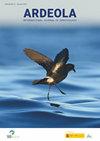Centrality in Species-Habitat Networks Reveals the Importance of Habitat Quality for High-Andean Birds in Polylepis Woodlands
IF 1.2
4区 生物学
Q2 ORNITHOLOGY
引用次数: 6
Abstract
Summary. Habitat loss and landscape fragmentation are important drivers of changes in biodiversity. In fragmented landscapes, bird species are able to use multiple forest patches that may therefore share an important portion of the regional biodiversity. In turn, these patches are linked through their shared bird diversity (i.e. species-habitat networks). Identifying the importance of nodes (e.g. forest patches) in species-habitat networks is increasingly important to improve conservation planning. Within this network approach, the relative importance of patches for birds can be identified via centrality indices-measures of the magnitude of shared bird diversity of patches across the entire network (i.e. patch centrality). Here, we tested for changes in patch centrality within bird species-patch networks of two habitat guilds, forest specialists and generalists, in relation to patch area, patch shape irregularity and within-patch habitat characteristics across 15 Polylepis woodland patches in a páramo landscape of southern Ecuador. Patch centrality for forest specialists decreased with greater influence of surrounding páramo plants, i.e. an increasing proportion of bunch-grasses and small shrubs, in the within-patch habitat and was unaffected by either patch area or patch shape irregularity. On the other hand, patch centrality for generalists was positively influenced by patch shape irregularity but was unaffected by patch area or the influence of surrounding páramo plants in the within-patch habitat. Patch centrality reveals that the relative importance of Polylepis woodlands lies in their habitat quality. Forest specialists are dependent on mature Polylepis woodland patches, while generalists benefit from the natural irregular shape of the woodlands. Finally, a species-habitat network approach facilitates the recognition of important Polylepis patches and their characteristics for conservation of the Andean bird community at a landscape scale.—Astudillo, P.X., Grass, I., Siddons, D.C., Schabo, D.G. & Farwig, N. (2020). Centrality in species-habitat networks reveals the importance of habitat quality for high-Andean birds in Polylepis woodlands. Ardeola, 67: 307-324.物种-栖息地网络的中心性揭示了高安第斯山地鸟类栖息地质量的重要性
总结。生境丧失和景观破碎化是生物多样性变化的重要驱动因素。在支离破碎的景观中,鸟类能够利用多个森林斑块,因此可能共享区域生物多样性的重要部分。反过来,这些斑块通过它们共同的鸟类多样性(即物种-栖息地网络)联系在一起。确定物种-栖息地网络中节点(如森林斑块)的重要性对改善保护规划越来越重要。在这种网络方法中,可以通过中心性指数来确定斑块对鸟类的相对重要性,中心性指数是衡量整个网络中斑块共享鸟类多样性程度的指标(即斑块中心性)。在这里,我们测试了两个栖息地协会(森林专家和通才)的鸟类物种斑块网络中斑块中心性的变化,以及斑块面积、斑块形状不规则性和斑块内栖息地特征在厄瓜多尔南部páramo景观中的15个Polylepis林地斑块中的变化。森林专家的斑块中心性随着斑块内生境中周围páramo植物(即丛草和小灌木的比例增加)的影响而降低,并且不受斑块面积或斑块形状不规则性的影响。另一方面,多面手的斑块中心性受斑块形状不规则性的正影响,而不受斑块面积或斑块内生境中周围páramo植物的影响。斑块中心性表明,毛缕草林地的相对重要性在于生境质量。森林专家依赖于成熟的水杉林地,而通才则受益于林地的自然不规则形状。最后,物种-栖息地网络方法有助于在景观尺度上识别安第斯鸟类群落保护的重要毛翅类斑块及其特征。-Astudillo, P.X, Grass, I., Siddons, d.c., Schabo, D.G.和Farwig, N.(2020)。物种-栖息地网络的中心性揭示了栖息质量对高安第斯山地鸟类的重要性。中国生物医学工程学报,27(6):307-324。
本文章由计算机程序翻译,如有差异,请以英文原文为准。
求助全文
约1分钟内获得全文
求助全文
来源期刊
CiteScore
2.30
自引率
6.20%
发文量
16
审稿时长
>12 weeks
期刊介绍:
Ardeola: International Journal of Ornithology is the scientific journal of SEO/BirdLife, the Spanish Ornithological Society. The journal had a regional focus when it was first published, in 1954. Since then, and particular during the past two decades, the journal has expanded its thematic and geographical scope. It is now a fully international forum for research on all aspects of ornithology. We thus welcome studies within the fields of basic biology, ecology, behaviour, conservation and biogeography, especially those arising from hypothesis-based research. Although we have a long publication history of Mediterranean and Neotropical studies, we accept papers on investigations worldwide.
Each volume of Ardeola has two parts, published annually in January and July. The main body of each issue comprises full-length original articles (Papersand Review articles) and shorter notes on methodology or stimulating findings (Short Communications). The publication language is English, with summaries, figure legends and table captions also in Spanish. Ardeolaalso publishes critical Book Reviewsand PhD-Dissertation Summaries; summarising ornithological theses defended in Spain. Finally there are two Spanish-language sections, Ornithological News; summarising significant recent observations of birds in Spain, and Observations of Rare Birds in Spain, the annual reports of the Spanish Rarities Committee.

 求助内容:
求助内容: 应助结果提醒方式:
应助结果提醒方式:


